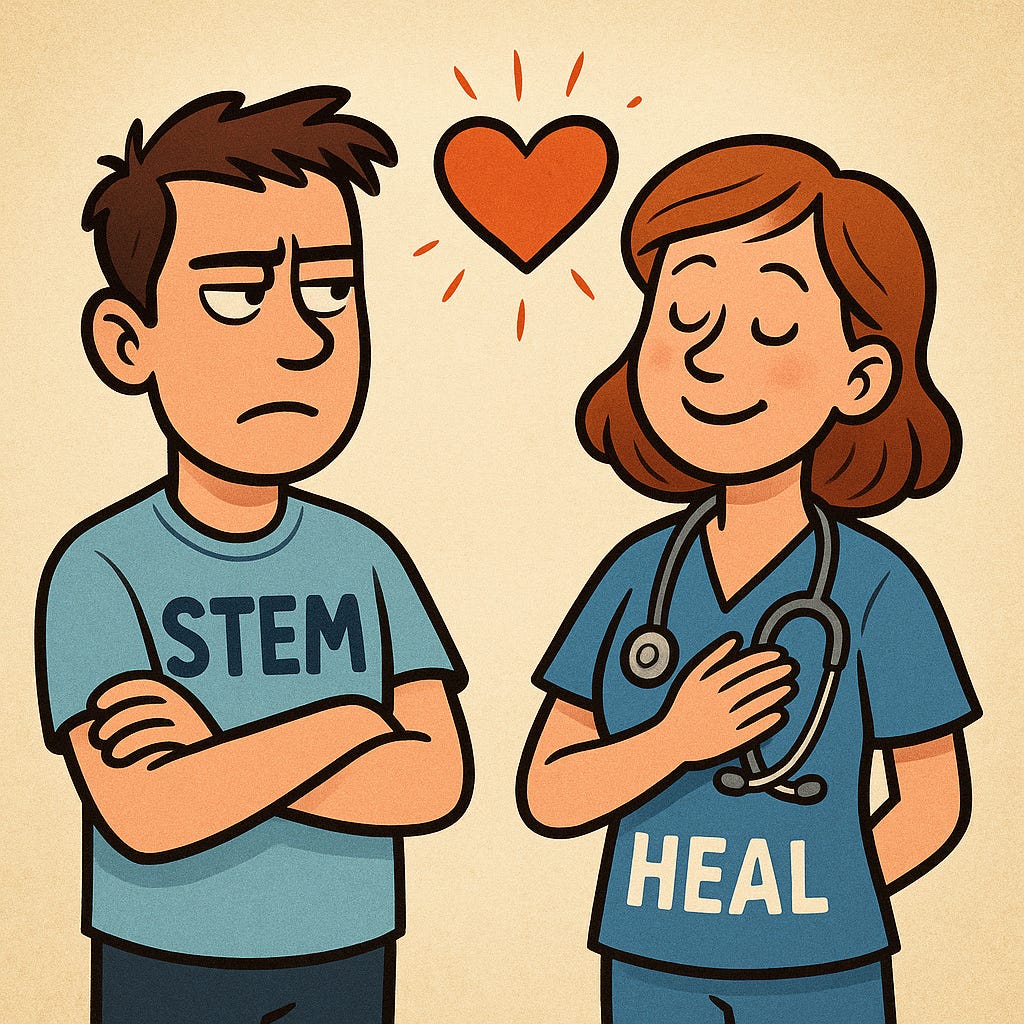Move Over STEM Jobs, Say Hello to “HEAL Occupations”
ProTip: The future might not belong to the coders, but to the caregivers.
For several decades, the gospel of career advice was simple: major in STEM, secure your future. The guidance was parroted like scripture. Learn to code. Learn to engineer. Learn to do anything but waste time in the liberal arts.
It wasn’t guidance—it was doctrine. STEM was the door marked “future-proof.”
But here’s the catch with American bubbles: whether it’s housing, college, crypto, or the Beanie Baby boom of ’99, sooner or later too many people crowd through the same door. And once again, the floor gives way.
According to the Census Bureau, 74% of STEM bachelor’s grads don’t even work in STEM. That’s not a typo. They’re in SaaS sales, project management, or manning the handful of IT help desks that haven’t been shipped offshore. And get this: unemployment for fresh computer engineering and physics grads is higher than for all young workers—degree or no degree.
So much for the “sure bet.” STEM is looking less like a safe harbor and more like a student debt trap with extra math requirements.
And then along came AI.
Picture it: you’re the golden child of STEM orthodoxy. You’ve got the comp sci degree, the GitHub portfolio, the coding bootcamp certificate, the fridge full of Soylent. You’re locked and loaded.
Then the CEO of Anthropic strolls into the Council on Foreign Relations and casually says AI could be writing 90% of new code. Meta is cutting mid-level coders. Google admits AI already writes a quarter of its new code. Stripe is downsizing engineers even as it grows elsewhere. Salesforce bragged about a 30% productivity boost from AI—then immediately laid off a thousand people.
The script says: “Don’t worry, AI won’t replace you, it’ll just make you more productive.” Translation: management gets the productivity, you get the pink slip.
One recent headline spelled it out: “Heads up students: computer science is now among the top ten majors with the highest unemployment.”
So what now? If STEM is no longer “future-proof,” what’s left standing after the AI tsunami?
The answer may be something most of us dismissed as “pink-collar” work: HEAL occupations—Health, Education, And Literacy. (This phrase was coined by Richard V. Reeves of the American Institute for Boys and Men.)
This isn’t about coding apps. It’s about the jobs that still require one human being looking another human being in the eye. Nurses. Teachers. Therapists. Medical assistants. Social workers. All the work of keeping people alive, literate, and functional in a society that likes to pretend chatbots can parent your kids.
Some numbers:
24 million HEAL jobs already exist, about one in seven U.S. jobs.
By 2033, the sector is projected to add 1.6 million more.
Two in five HEAL jobs don’t require a bachelor’s degree.
The median wage? About $64,000. Less than STEM’s $102k, but higher than the $43k average for everyone else.
While women have tripled their share of STEM jobs since 1970 (from 9% to 26%), men have reduced their representation in HEAL. Back then, nearly a third of HEAL workers were male. Now it’s just 27%. HEAL jobs won’t make you a crypto billionaire. But they do something STEM jobs increasingly don’t: they survive automation.
AI can scrape StackOverflow and regurgitate Python scripts. It can’t hold the hand of a frightened patient, break up a classroom fight, or sit down with a dyslexic kid struggling to read. These jobs depend on unpredictability, emotional intelligence, persuasion—the human skills that don’t fit neatly into an algorithm.
And that’s the irony. For years, “soft skills” were treated as fluffy filler. Now they’re the hardest currency in the labor market.
Acronyms are destiny
STEM wasn’t inevitable. It was a branding exercise that worked. Washington, universities, think tanks—everybody agreed to chant the same four letters, and resources followed.
So maybe it’s time to give HEAL the same treatment. The acronym is catchy. The work is real. The demand is growing. We’ve spent decades teaching kids to act like machines. Now the machines have caught up. The future might not belong to the coders, but to the caregivers


